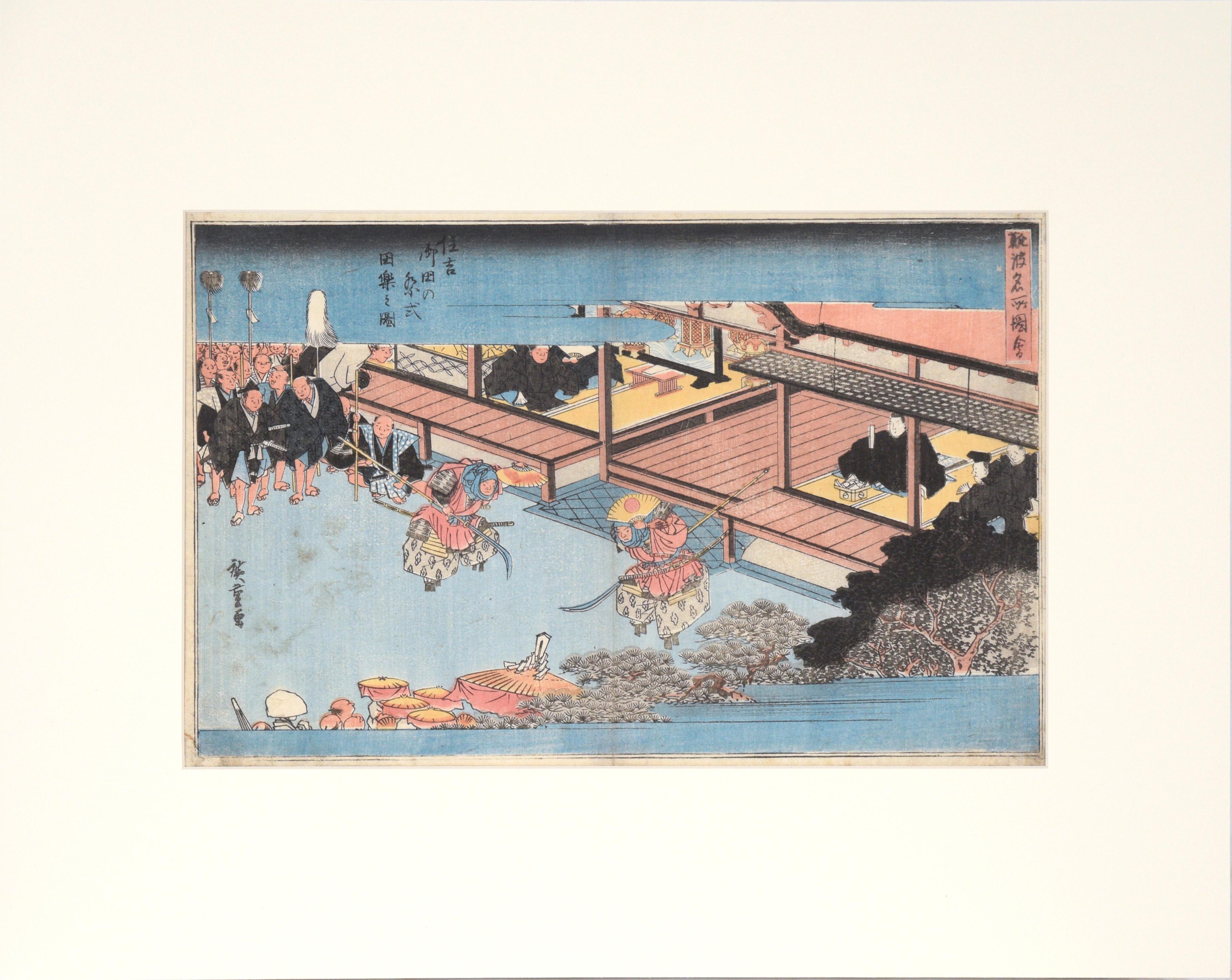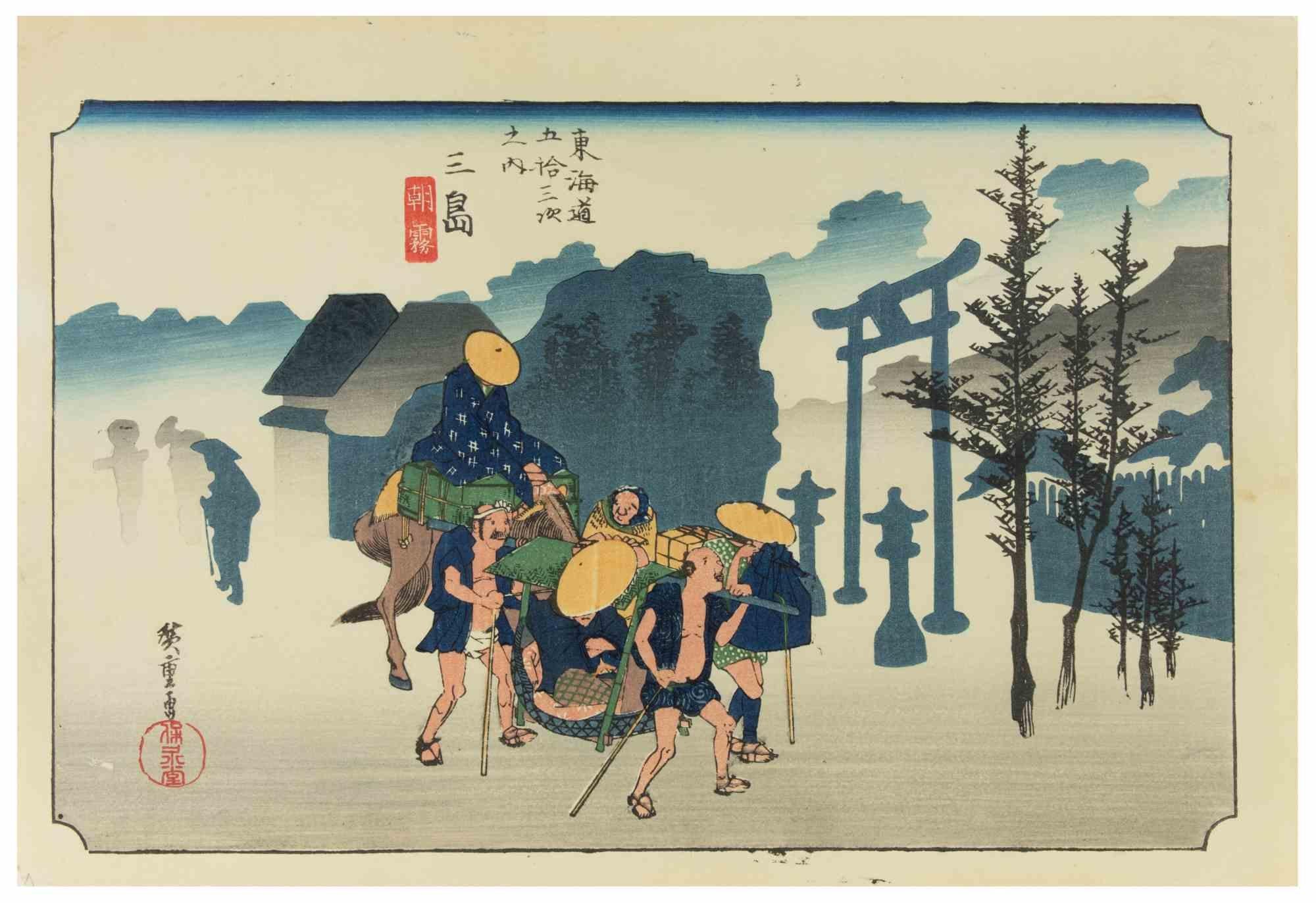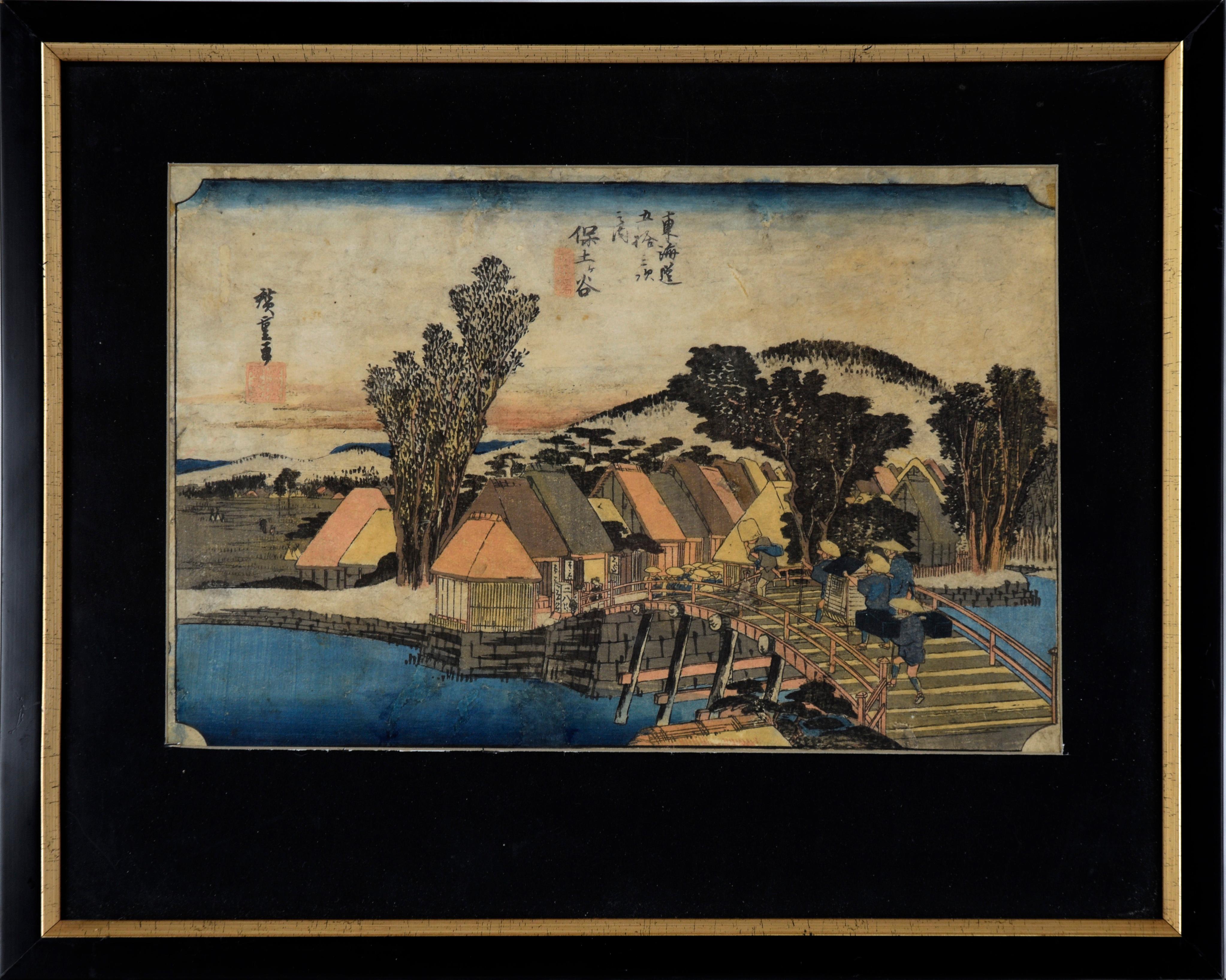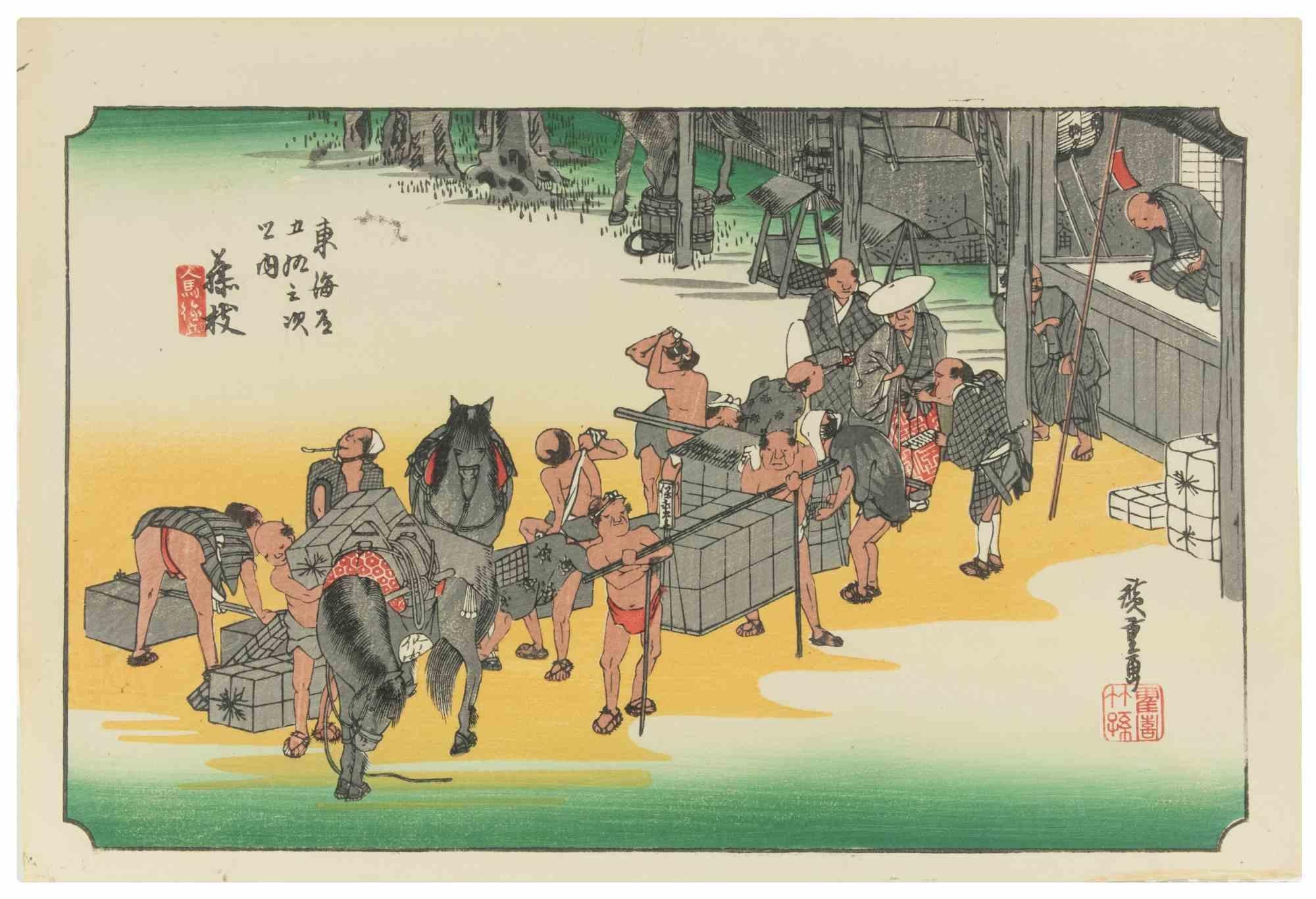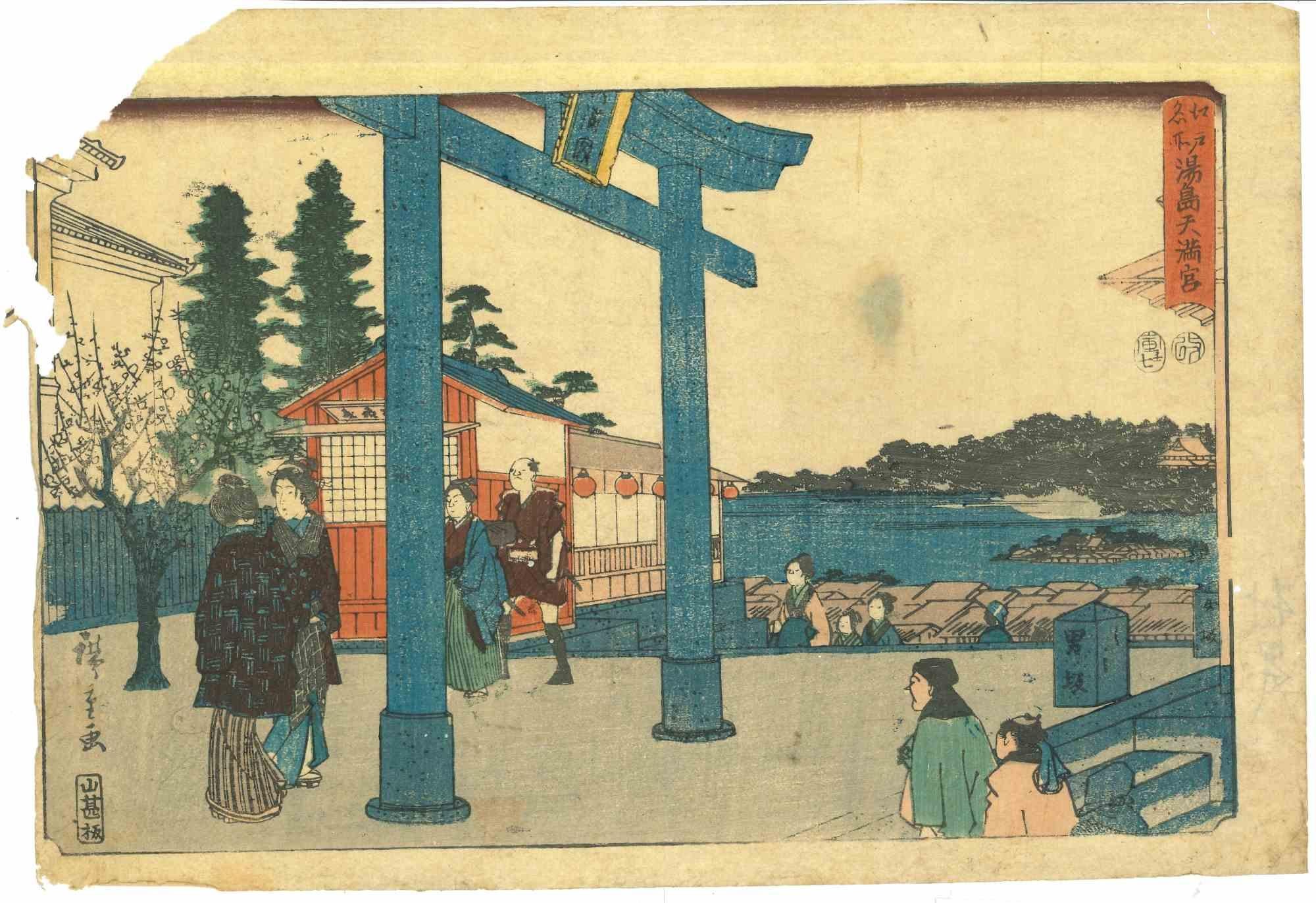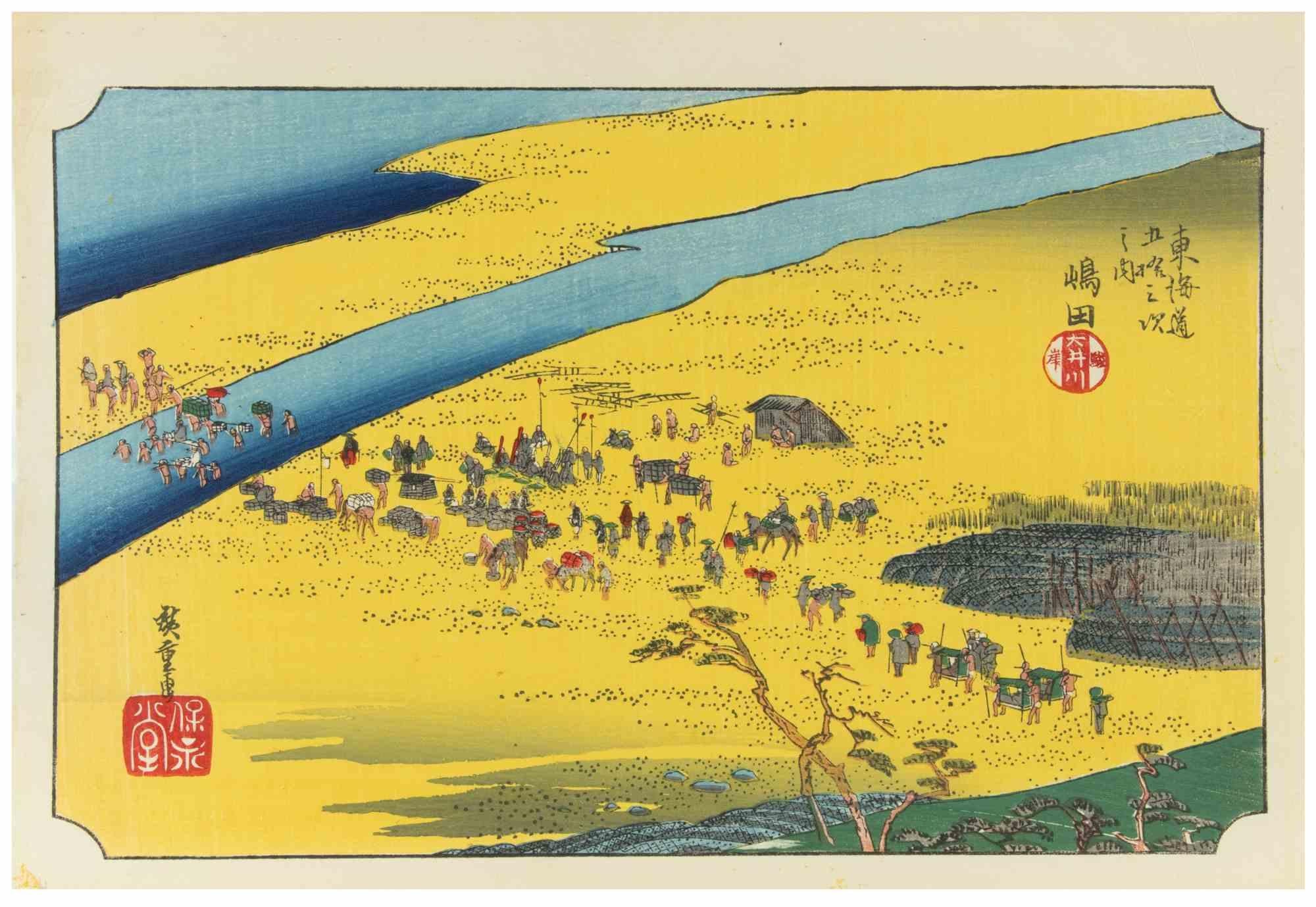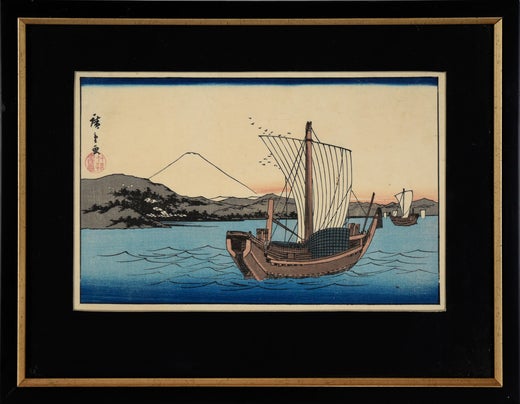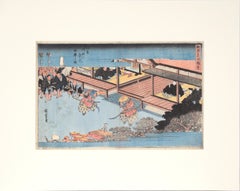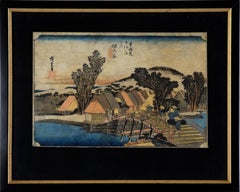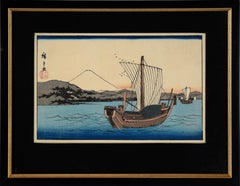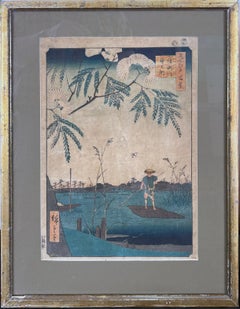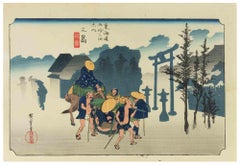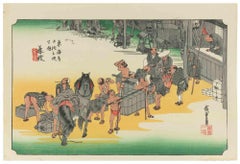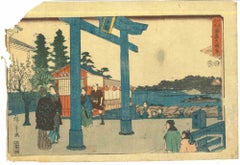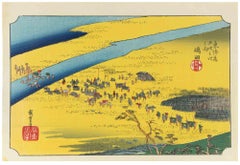Items Similar to Stage 48 of the 53 Stages of the Tokaido - Japanese Woodblock on Rice Paper
Want more images or videos?
Request additional images or videos from the seller
1 of 11
Utagawa HiroshigeStage 48 of the 53 Stages of the Tokaido - Japanese Woodblock on Rice Paper1833
1833
$1,240
$1,55020% Off
£935.79
£1,169.7420% Off
€1,071.34
€1,339.1820% Off
CA$1,748.81
CA$2,186.0120% Off
A$1,919.98
A$2,399.9720% Off
CHF 1,001.66
CHF 1,252.0720% Off
MX$23,234.39
MX$29,042.9920% Off
NOK 12,554.20
NOK 15,692.7520% Off
SEK 11,829.36
SEK 14,786.7020% Off
DKK 7,997.29
DKK 9,996.6120% Off
About the Item
Stage 48 of the 53 Stages of the Tokaido - Japanese Woodblock on Rice Paper
Woodblock print of clothing vendors by Utagawa Hiroshige (Japanese, 1797-1858). Originally printed in 1833, this scene depicts Seki station on the Tokaido Road, with travelers outside a men's clothing shop selling hats and short kimonos. There are also people standing at the entrance to a gated area, near some shops that are closed with painted designs on fabric.
Presented in a black frame with a mat.
Frame size: 15.5"H x 19.25"W
Paper size: 9.5"H x 13.75"W
Born in Edo as Tokutaro Ando, Hiroshige Utagawa grew up in a minor samurai family. His father belonged to the firefighting force assigned to Edo Castle. It is here that Hiroshige was given his first exposure to art: legend has it that a fellow fireman tutored him in the Kano school of painting, though Hiroshige’s first official teacher was Rinsai. Though Hiroshige tried to join Toyokuni Utagawa's studio, he was turned away. In 1811, young Hiroshige entered an apprenticeship with the celebrated Toyohiro Utagawa. After only a year, he was bestowed with the artist name Hiroshige. He soon gave up his role in the fire department to focus entirely on painting and print design. During this time he studied painting, intrigued by the Shijo school. Hiroshige’s artistic genius went largely unnoticed until 1832.
In Hiroshige Utagawa's groundbreaking series of Japanese woodblock prints, The 53 Stations of the Tokaido (1832-1833), he captured the journey along the Tokaido road, the highway connecting Edo to Kyoto, the imperial capital. With the Tokugawa Shogunate relaxing centuries of age-old restrictions on travel, urban populations embraced travel art and Hiroshige Utagawa became one of the most prominent and successful ukiyo-e artists. He also produced kacho-e (bird-and-flower pictures) to enormous success. In 1858, at the age of 61, he passed away as a result of the Edo cholera epidemic.
Hiroshige Utagawa’s woodblock prints continue to convey the beauty of Japan and provide insight into the everyday life of its citizens during the Edo period. The appeal of his tender, lyrical landscapes was not restricted to the Japanese audience. Hiroshige’s work had a profound influence on the Impressionists and Post-Impressionists of Europe: Toulouse-Lautrec was fascinated with Hiroshige’s daring diagonal compositions and inventive use of perspective, while Van Gogh literally copied two of Hiroshige's prints from the famous series, 100 Famous Views of Edo in oil paint.
- Creator:Utagawa Hiroshige (1797)
- Creation Year:1833
- Dimensions:Height: 15.5 in (39.37 cm)Width: 19.25 in (48.9 cm)Depth: 1.25 in (3.18 cm)
- Medium:
- Movement & Style:
- Period:
- Condition:Overall good condition. Mounted "floating" in the frame. Frame is used and has some minor signs of wear.
- Gallery Location:Soquel, CA
- Reference Number:Seller: DBH93221stDibs: LU54214629652
Utagawa Hiroshige
Utagawa Hiroshige (1797 - 1858) was a Japanese ukiyo-e artist, considered the last great master of that tradition. Hiroshige is best known for his horizontal-format landscape series The Fifty-three Stations of the Tōkaidō and for his vertical-format landscape series One Hundred Famous Views of Edo. The subjects of his work were atypical of the ukiyo-e genre, whose typical focus was on beautiful women, popular actors, and other scenes of the urban pleasure districts of Japan's Edo period (1603–1868). The popular series Thirty-six Views of Mount Fuji by Hokusai was a strong influence on Hiroshige's choice of subject, though Hiroshige's approach was more poetic and ambient than Hokusai's bolder, more formal prints. Subtle use of color was essential in Hiroshige's prints, often printed with multiple impressions in the same area and with extensive use of bokashi (color gradation), both of which were rather labor-intensive techniques. For scholars and collectors, Hiroshige's death marked the beginning of a rapid decline in the ukiyo-e genre, especially in the face of the westernization that followed the Meiji Restoration of 1868. Hiroshige's work came to have a marked influence on Western painting towards the close of the 19th century as a part of the trend in Japonism. Western artists, such as Manet and Monet, collected and closely studied Hiroshige's compositions. Vincent van Gogh even went so far as to paint copies of two of Hiroshige's prints from One Hundred Famous Views of Edo.
About the Seller
5.0
Platinum Seller
Premium sellers with a 4.7+ rating and 24-hour response times
Established in 1986
1stDibs seller since 2014
3,000 sales on 1stDibs
Typical response time: <1 hour
- ShippingRetrieving quote...Shipping from: Soquel, CA
- Return Policy
Authenticity Guarantee
In the unlikely event there’s an issue with an item’s authenticity, contact us within 1 year for a full refund. DetailsMoney-Back Guarantee
If your item is not as described, is damaged in transit, or does not arrive, contact us within 7 days for a full refund. Details24-Hour Cancellation
You have a 24-hour grace period in which to reconsider your purchase, with no questions asked.Vetted Professional Sellers
Our world-class sellers must adhere to strict standards for service and quality, maintaining the integrity of our listings.Price-Match Guarantee
If you find that a seller listed the same item for a lower price elsewhere, we’ll match it.Trusted Global Delivery
Our best-in-class carrier network provides specialized shipping options worldwide, including custom delivery.More From This Seller
View AllSumiyoshi: Dengaku dance performed during an Onda ceremony - Woodblock Print
By Utagawa Hiroshige
Located in Soquel, CA
Sumiyoshi: Dengaku dance performed during an Onda ceremony - Woodblock Print
Bright woodblock print by Utagawa Hiroshige (Japanese, 1797-1858). In this scene, two dancers with swords and fans are facing each other, in the center of a courtyard. There are spectators surrounding them, including nobles in black clothing on a balcony.
Presented in a new off-white mat with foamcore backing.
Mat size: 16"H x 20"W
Paper size: 9.63"H x 14.5W"
Utagawa Hiroshige (1797-1858, sometimes called Ando Hiroshige) was the second of the two great masters of the Japanese landscape woodblock print...
Category
1830s Edo Figurative Prints
Materials
Ink, Rice Paper, Woodcut
Shin-machi Bridge at Hodogaya - Japanese Woodcut Print on Rice Paper
By Utagawa Hiroshige
Located in Soquel, CA
Shin-machi Bridge at Hodogaya - Japanese Woodcut Print on Rice Paper
Woodblock print of travelers on a bridge by Utagawa Hiroshige (Japanese, 1797-185...
Category
1850s Impressionist Figurative Prints
Materials
Rice Paper, Woodcut
$1,240 Sale Price
20% Off
Kiyomi Barrier & Seiken Temple Near Okitsu- Japanese Woodcut Print on Rice Paper
By Utagawa Hiroshige
Located in Soquel, CA
Kiyomi Barrier & Seiken Temple Near Okitsu - Japanese Woodcut Print on Rice Paper
Woodblock print of boats in a harbor by Utagawa Hiroshige (Japanese, 1797-1858). Originally publish...
Category
1850s Impressionist Figurative Prints
Materials
Rice Paper, Woodcut
The Ayase River and Kanegafuchi, Summer, One Hundred Famous Views of Edo
By Utagawa Hiroshige (Ando Hiroshige)
Located in Soquel, CA
The Ayase River and Kanegafuchi, Summer, One Hundred Famous Views of Edo
Summer on the Ayase River by Hiroshige (Ando) Utagawa (Japan, 1797 - 1858 ). Woodcut circa 1856.
Ima...
Category
1850s Realist Figurative Prints
Materials
Ink, Woodcut
Kiyomizu Temple, Scenes of Famous Places along Tôkaidô Road - Woodblock on Paper
By Utagawa Hiroshige II
Located in Soquel, CA
Kiyomizu Temple, Scenes of Famous Places along Tôkaidô Road - Woodblock on Paper
Full Title:
Kyoto: Kiyomizu Temple (Kyô Kiyomizudera), from the series Scenes of Famous Places along...
Category
1860s Edo Landscape Prints
Materials
Ink, Rice Paper, Woodcut
"The Kaminarimon at the Kanseon Temple in Asakusa" - Original Japanese Print
Located in Soquel, CA
"The Kaminarimon at the Kanseon Temple in Asakusa" - Original Japanese Print
Japanese Print "The Kaminarimon at the Kanseon Temple in Asakusa", from the series "Famous Places in Ed...
Category
1850s Showa Figurative Prints
Materials
Rice Paper, Woodcut
You May Also Like
Asagiri - Woodcut by Utagawa Hiroshige - 1832
By Utagawa Hiroshige
Located in Roma, IT
Asagiri is a woodcut print realized by Utagawa Hiroshige in 1832.
It is part of the suite "The Fifty-three Stations of Tokaido".
Very good condition.
Category
1830s Modern Figurative Prints
Materials
Woodcut
Seki - Woodcut by Utagawa Hiroshige - 1833
By Utagawa Hiroshige
Located in Roma, IT
Seki is a woodcut print realized by Utagawa Hiroshige in 1833.
It is part of the suite "The Fifty-three Stations of Tokaido".
Very good condition.
Category
1830s Modern Figurative Prints
Materials
Woodcut
Japanese Woodcut Print - Original Woodcut Print by Utagawa Hiroshige - 19th Cent
By Utagawa Hiroshige
Located in Roma, IT
This is a superb polychrome woodblock print (nishiki-e, ink and color on paper), likely realized by Utagawa Hiroshige (Japanese, 1797-1858) at the middle of 19th century. This plate ...
Category
19th Century Modern Figurative Prints
Materials
Woodcut
Shimada - Woodcut by Utagawa Hiroshige - 1833
By Utagawa Hiroshige
Located in Roma, IT
Asagiri is a woodcut print realized by Utagawa Hiroshige in 1832.
It is part of the suite "The Fifty-three Stations of Tokaido".
Very good condition.
Category
1830s Modern Figurative Prints
Materials
Woodcut
Kasumigaseki Nokei - Woodcut by Utagawa Hiroshige - 1840
By Utagawa Hiroshige
Located in Roma, IT
Kasumigaseki Nokei is a polychrome woodblock print (nishiki-e, ink and colour on paper) by Utagawa Hiroshige (Japanese, 1797-1858). This plate is from the print suite Famous Places o...
Category
1840s Modern Figurative Prints
Materials
Woodcut
Akasaka - Woodcut by Utagawa Hiroshige - 1831
By Utagawa Hiroshige
Located in Roma, IT
Akasaka is a polychrome woodblock print, the plate n. 36 from the series - Fifty-three Stations of the Tôkaidô (Ryosha Shofu npo Zu), designed by Utagawa Hiroshige (歌川 広重, 1797-1858)...
Category
Mid-19th Century Figurative Prints
Materials
Paper, Woodcut
More Ways To Browse
Antique Mens Clothing
Antique Firemans
Antique Men Hats
Japanese Woodblock Prints Hiroshige
Utagawa Hiroshige On Sale
Dali Vitraux
Damien Hirst Mickey
Damien Hirst Minnie
David Bathsheba
Deborah Azzopardi
Divan Japonais
Donald Easton
Dr Atl
Dubonnet Poster
Fashion Pochoir
Foire De Paris Print
Four Freedom Poster
Francis Bacon Poster
